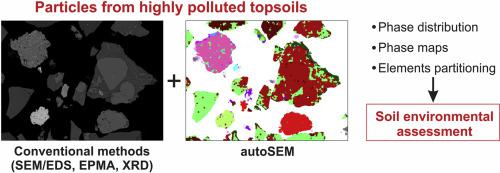Environmental Pollution ( IF 7.6 ) Pub Date : 2020-07-01 , DOI: 10.1016/j.envpol.2020.115118 Marek Tuhý 1 , Tomáš Hrstka 2 , Vojtěch Ettler 1

|
Topsoils near active and abandoned mining and smelting sites are highly polluted by metal(loid) contaminants, which are often bound to particulates emitted from ore processing facilities and/or windblown from waste disposal sites. To quantitatively determine the contaminant partitioning in the soil particulates, we tested an automated mineralogy approach on the heavy mineral fraction extracted from the mining- and smelting-polluted topsoils exhibiting up to 1920 mg/kg As, 5840 mg/kg Cu, 4880 mg/kg Pb and 3310 mg/kg Zn. A new generation of automated scanning electron microscopy (autoSEM) was combined and optimized with conventional mineralogical techniques (XRD, SEM/EDS, EPMA). Parallel digestions and bulk chemical analyses were used as an independent control of the autoSEM-calculated concentrations of the key elements. This method provides faster data acquisition, the full integration of the quantitative EDS data and better detection limits for the elements of interest. We found that As was mainly bound to the apatite group minerals, slag glass and metal arsenates. Copper was predominantly hosted by the sulfides/sulfosalts and the Cu-bearing secondary carbonates. The deportment of Pb is relatively complex: slag glass, Fe and Mn (oxyhydr)oxides, metal arsenates/vanadates and cerussite were the most important carriers for Pb. Zinc is mainly bound to the slag glass, Fe (oxyhydr)oxides, smithsonite and sphalerite. Limitations exist for the less abundant contaminants, which cannot be fully quantified by autoSEM due to spectral overlaps with some major elements (e.g., Sb vs. Ca, Cd vs. K and Ca in the studied soils). AutoSEM was found to be a useful tool for the determination of the modal phase distribution and element partitioning in the metal(loid)-bearing soil particulates and will definitely find more applications in environmental soil sciences in the future.
中文翻译:

自动化矿物学技术,用于量化和分配采矿/冶炼污染土壤中的颗粒中的金属(胶体)。
活跃和废弃的采矿和冶炼场所附近的表土受到金属(金属)污染物的严重污染,这些污染物通常与矿石加工设施排放的颗粒和/或废物处理场所的风吹尘结合。为了定量确定污染物在土壤颗粒中的分配,我们测试了一种自动矿物学方法,该方法对采矿和冶炼污染的表层土壤中提取的重矿物成分进行了分析,这些土壤的最高砷含量为1920 mg / kg,铜含量为5840 mg / kg,4880 mg / kg kg Pb和3310 mg / kg Zn。新一代的自动扫描电子显微镜(autoSEM)与常规的矿物学技术(XRD,SEM / EDS,EPMA)相结合并进行了优化。平行消化和大量化学分析被用作自动SEM计算的关键元素浓度的独立控制。这种方法提供了更快的数据采集,定量EDS数据的完全整合以及对所关注元素的更好检测限。我们发现,砷主要与磷灰石类矿物,矿渣玻璃和金属砷酸盐结合。铜主要由硫化物/亚硫酸盐和含铜的仲碳酸盐构成。铅的迁移相对复杂:矿渣玻璃,铁和锰(羟基氧化物)氧化物,金属砷酸盐/钒酸盐和陶粒是铅的最重要载体。锌主要与炉渣玻璃,氧化铁(羟基氧化物),新铁矿和闪锌矿结合。由于污染物与一些主要元素(例如,研究土壤中的Sb对Ca,Cd对K和Ca)的光谱重叠,存在数量较少的污染物存在局限性,无法通过autoSEM完全量化。











































 京公网安备 11010802027423号
京公网安备 11010802027423号